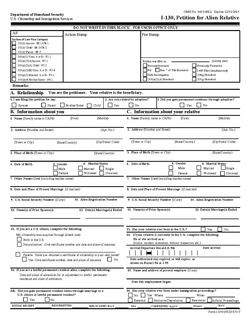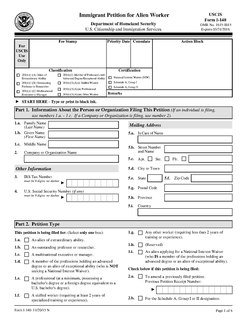Related Research Articles

A green card, known officially as a permanent resident card, is an identity document which shows that a person has permanent residency in the United States. Green card holders are formally known as lawful permanent residents (LPRs). As of 2019, there are an estimated 13.9 million green card holders, of whom 9.1 million are eligible to become United States citizens. Approximately 65,000 of them serve in the U.S. Armed Forces.
The H-1B is a visa in the United States under the Immigration and Nationality Act, section 101(a)(15)(H) that allows U.S. employers to temporarily employ foreign workers in specialty occupations. A specialty occupation requires the application of specialized knowledge and a bachelor's degree or the equivalent of work experience. The duration of stay is three years, extendable to six years; after which the visa holder may need to reapply. Laws limit the number of H-1B visas that are issued each year: 188,100 new and initial H-1B visas were issued in 2019. Employers must generally withhold Social Security and Medicare taxes from the wages paid to employees in H-1B status.
An L-1 visa is a visa document used to enter the United States for the purpose of work in L-1 status. It is a non-immigrant visa, and is valid for a relatively short amount of time, from three months to five years, based on a reciprocity schedule. With extensions, the maximum stay is seven years.
TN status or TN visa is a special non-immigrant classification in the United States that offers expedited work authorization to a citizen of Canada or a national of Mexico, created as a result of provisions of the North American Free Trade Agreement that mandate simplified entry and employment permission for certain professionals from each of the three NAFTA member states in the other member states.
Priority date is a United States immigration concept – it is the date when a principal applicant first reveals his or her intent of immigration to the US government. For family-sponsored applicants, the priority date is the date an immigration petition, filed on behalf of him or her, is received by the United States Citizenship and Immigration Services (USCIS). For employment-based immigration beneficiaries, the priority date is the date an immigration petition is filed at USCIS, under categories where a labor certification is not required, or when the United States Department of Labor receives a labor certification application, under categories where a labor certification is required. In all cases, the priority dates are not established until USCIS approves the immigration petition. The date establishes one's place in the queue for a family-sponsored or employment-based or permanent residency permit application.
Labor certification is an immigration process step in the United States of America. Its stated goal is to "protect U.S. workers and the U.S. labor market by ensuring that foreign workers seeking immigrant visa classifications are not displacing equally qualified U.S. workers".
An H-2A visa allows a foreign national worker into the United States for temporary agricultural work. There are several requirements of the employer in regard to this visa. The H-2A temporary agricultural program establishes a means for agricultural employers who anticipate a shortage of domestic workers to bring non-immigrant foreign workers to the U.S. to perform agricultural labor or services of a temporary or seasonal nature. In 2015 there were approximately 140,000 total temporary agricultural workers under this visa program. Terms of work can be as short as a month or two or as long as 10 months in most cases, although there are some special procedures that allow workers to stay longer than 10 months. All of these workers are covered by U.S. wage laws, workers' compensation and other standards; additionally, temporary workers and their employers are subject to the employer and/or individual mandates under the Affordable Care Act. Because of concern that guest workers might be unfairly exploited the U.S. Department of Labor Wage and Hour Division is especially vigilant in auditing and inspecting H-2A employers. H-2A employers are the only group of employers who are required to pay inbound and outbound transportation, free housing, and provide meals for their workers. H-2A agricultural employers are among the most heavily regulated and monitored employers in the United States. Unlike other guest worker programs, there is no cap on the number of H-2A visas allocated each year.
The EB-1 is a preference category for United States employment-based permanent residency. It is intended for "priority workers". Those are foreign nationals who either have "extraordinary abilities", or are "outstanding professors or researchers", and also includes "some executives and managers of foreign companies who are transferred to the US". It allows them to remain permanently in the US.
EB-2 is an immigrant visa preference category for United States employment-based permanent residency, created by the Immigration Act of 1990. The category includes "members of the professions holding advanced degrees or their equivalent", and "individuals who because of their exceptional ability in the sciences, arts, or business will substantially benefit prospectively the national economy, cultural or educational interests, or welfare of the United States, and whose services in the sciences, arts, professions, or business are sought by an employer in the United States". Applicants must generally have an approved labor certification, a job offer, and their employer must have filed an Immigrant Petition for Alien Worker with the USCIS.
The American Competitiveness in the 21st Century Act (AC21) was an act passed by the government of the United States in October 2000, pertaining to immigration to the United States. It was a complement to the American Competitiveness and Workforce Improvement Act that had been passed in 1998. The focus of AC21 was to change rules related to portability and caps for the H-1B visa to increase the effective number of visas available and make it easier for workers on those visas to switch jobs. Although the language of the Act references the Immigration and Naturalization Service (INS), the INS would soon be restructured and the functions of the INS referenced in AC21 would be handled by United States Citizenship and Immigration Services.
Premium Processing Service refers to an optional premium service offered by the United States Citizenship and Immigration Services to employers filing Form I-129 or Form I-140. To avail of the service, the employer needs to file Form I-907 and include a fee that is $1,500 for the H-2B and R classifications and $2,500 for all others.
The United States Citizenship and Immigration Services (USCIS) issues a number of forms for people to submit to them relating to immigrant and non-immigrant visa statuses. These forms begin with the letter "I". None of the forms directly grants a United States visa, but approval of these forms may provide authorization for staying or extending one's stay in the United States as well as authorization for work. Some United States visas require an associated approved USCIS immigration form to be submitted as part of the application.

Form I-130, Petition for Alien Relative is a form submitted to the United States Citizenship and Immigration Services by a United States citizen or Lawful Permanent Resident petitioning for an immediate or close relative intending to immigrate to the United States. It is one of numerous USCIS immigration forms. As with all USCIS petitions, the person who submits the petition is called the petitioner and the relative on whose behalf the petition is made is called the beneficiary. The USCIS officer who evaluates the petition is called the adjudicator.
The United States Citizenship and Immigration Services is a subdivision of the U.S. Department of Homeland Security that adjudicates petitions and processes forms related to citizenship, residency, and various kinds of authorization to live and work in the United States. Many of the forms it processes are prerequisites for people outside the United States who are not United States citizens or permanent residents to obtaining visas to enter the United States in the specified status. Many of the USCIS immigration forms have long processing times. The USCIS offers some guidance regarding expected processing times through its website and through reports. This page describes the USCIS policies, the guidance they offer, and the courses of action in case of higher processing times.
The National Visa Center (NVC) is a center that is part of the U.S. Department of State that plays the role of holding United States immigrant visa petitions approved by the United States Citizenship and Immigration Services until an immigrant visa number becomes available for the petition, at which point it arranges for the visa applicant(s) to take the visa interview at a consulate abroad. It is located in Portsmouth, New Hampshire. It was established on July 26, 1994, on the site of an Air Force base that was closed down by The Pentagon.
The Legal Immigration Family Equity Act of 2000, also known as the LIFE Act and as the Legal Immigration and Family Equity Act, along with its Amendments, made some changes to laws surrounding immigration for family members of United States citizens and Lawful Permanent Residents, as well as people eligible for employment-based immigrant visas, in the direction of making it easier for family members and immigrant workers to move to and adjust status within the United States. It was passed on December 21, 2000, as title XI of Pub.L. 106–553 (text)(PDF).

Form I-140, Immigrant Petition for Alien Worker is a form submitted to the United States Citizenship and Immigration Service (USCIS) by a prospective employer to petition an alien to work in the US on a permanent basis. This is done in the case when the worker is deemed extraordinary in some sense or when qualified workers do not exist in the US. The employer who files is called the petitioner, and the alien employee is called the beneficiary; these two can coincide in the case of a self-petitioner. The form is 6 pages long with a separate 10-page instructions document as of 2016. It is one of the USCIS immigration forms.
A National Interest Waiver is an exemption from the labor certification process and job offer requirement for advanced degree/exceptional ability workers applying for an EB-2 Visa for Immigration into the United States.
The H-1A visa was a visa that was previously available to foreign nationals seeking temporary employment in the United States. These visas were made available to foreign nurses coming into the United States to perform services as a registered nurse in areas with a shortage of health professionals as determined by the Department of Labor. The creation of this visa was prompted by the nursing shortage.
The R-1 visa is a non-immigrant visa which allows travel to the United States for service as a minister or other religious occupation. Between October 2019 and September 2020, there were 2,399 R visas issued.
References
- 1 2 "Employment-Based Immigration: Third Preference EB-3". USCIS.
- ↑ "The First Steps toward an Immigrant Visa: Labor Certification and Filing a Petition". Employment-Based Immigrant Visas. Bureau of Consular Affairs. Archived from the original on 15 September 2012. Retrieved 27 August 2012.
- 1 2 "Employment Based Green Cards". ImmInfo.com. Archived from the original on 2011-11-21. Retrieved 2012-08-23.
- ↑ "Employment-Based Immigration: Third Preference EB-3 | USCIS". 2 December 2020.
- ↑ "Visa Bulletin For September 2012". Bureau of Consular Affairs. 2012-08-23. Archived from the original on 2012-08-15. Retrieved 2012-08-23.
- ↑ "EB-3 Bachelor's degree, Skilled Workers". 2009-02-02. Archived from the original on 2012-08-23. Retrieved 2012-08-23.
- ↑ "EB-3 vs. EB-5 Visa". Monday, 4 March 2019
- ↑ "Fees for Visa Services". Bureau of Consular Affairs . Retrieved 2016-02-08.
- ↑ "Check Filing Fees". Department of Homeland Security. USCIS . Retrieved 2016-02-08.